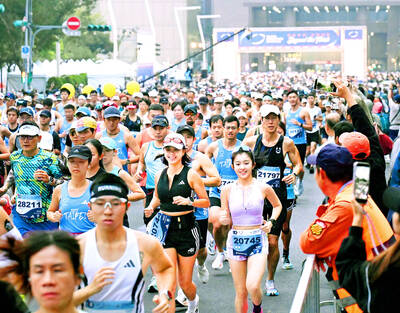After hanging over the entrance of the Presidential Office since 1948, a sign criticized as a relic of authoritarianism was replaced yesterday by the Democratic Progressive Party (DPP) administration, officially changing the office's name.
The name of the Presidential Office was "Chiehshou Hall" -- literally "Long live Kai-shek Hall" -- and the building had a marble sign with its name inscribed in Chinese characters (
The new sign, installed yesterday, reads simply "Presidential Office" in Chinese characters (
A statement by the Presidential Office said the move reflected not only the real sense of the building's name but also had constitutional meaning.
The marble sign reading "Chiehshou Hall" will be placed in the Academia Historica for public display, said a statement issued by the Presidential Office's Department of Public Affairs yesterday.
The department said the move was appropriate, because the building is where the president and vice president work, rather than a specific individual's personal villa or hall.
"Changing the name over the building's entrance from `Chieh-shou Hall' to `Presidential Office' not only makes the building worthy of its genuine name, but also carries constitutional meaning," the statement said.
colonial past
The Presidential Office's history stretches back to the Japanese colonial era. It was designed by the architect Uheiji Nagano in 1910, and was completed in 1919. The building, which was the office of the Japanese governor-general of Taiwan, was bombed by Allied forces during World War II, on May 31, 1945. Part of the building was destroyed in the bomb attack, and burned for three days.
One year after the war ended, the Taiwan Provincial Government raised funds to restore the building. The rehabilitation project was completed in 1948, and the building was named "Chiehshou Hall."
When the Chinese Nationalist Party (KMT) was defeated by the Chinese Communist Party during the Civil War, the remnants of its forces fled to Taiwan in 1949. The building became the office of the president and the premier in 1950. The office of the premier was later moved out of the building, in 1957.
The department said that as Taiwan has transformed from an authoritarian state to a genuine democracy, the name change was necessary and symbolized the restoration of power from the state to the people.
The department said that it began planning the change in October.
The Taiwan Solidarity Union (TSU) caucus yesterday said the name change "liberates Taiwan's democracy."
"Naming all the important buildings after Chiang Kai-shek (
`boring' move
However, opposition lawmakers criticized the Presidential Office, saying the move was "boring" and meaningless. Some equated the change to China's Cultural Revolution.
"Taiwan's 23 million people should be the focus of the government. Unfortunately, our government only cares about something like this. Changing names? I think there are a lot of better things to do, aren't there?" said Chinese Nationalist Party (KMT) Legislator Pan Wei-kang (
People First Party (PFP) Legislator Lee Hung-chun (
"If [the DPP government] wants to do something remarkable, I would suggest it focus on economic and criminal issues, because these issues concern everyone of us," Lee said.
The Democratic Progressive Party (DPP) caucus said the Presidential Office was merely doing something that needed to be done.
"What do you want to call the president's office if you do not call it the `Presidential Office?'" said DPP legislative caucus secretary-general Yeh Yi-ching (
The change should have "been made a long time ago, anyway," Yeh added.

TRAGEDY STRIKES TAIPEI: The suspect died after falling off a building after he threw smoke grenades into Taipei Main Station and went on a killing spree in Zhongshan A 27-year-old suspect allegedly threw smoke grenades in Taipei Main Station and then proceeded to Zhongshan MRT Station in a random killing spree that resulted in the death of the suspect and two other civilians, and seven injured, including one in critical condition, as of press time last night. The suspect, identified as a man surnamed Chang Wen (張文), allegedly began the attack at Taipei Main Station, the Taipei Fire Department said, adding that it received a report at 5:24pm that smoke grenades had been thrown in the station. One man in his 50s was rushed to hospital after a cardiac arrest

SAFETY FIRST: Double the number of police were deployed at the Taipei Marathon, while other cities released plans to bolster public event safety Authorities across Taiwan have stepped up security measures ahead of Christmas and New Year events, following a knife and smoke bomb attack in Taipei on Friday that left four people dead and 11 injured. In a bid to prevent potential copycat incidents, police deployments have been expanded for large gatherings, transport hubs, and other crowded public spaces, according to official statements from police and city authorities. Taipei Mayor Chiang Wan-an (蔣萬安) said the city has “comprehensively raised security readiness” in crowded areas, increased police deployments with armed officers, and intensified patrols during weekends and nighttime hours. For large-scale events, security checkpoints and explosives

PUBLIC SAFETY: The premier said that security would be tightened in transport hubs, while President Lai commended the public for their bravery The government is to deploy more police, including rapid response units, in crowded public areas to ensure a swift response to any threats, President William Lai (賴清德) said yesterday after a knife attack killed three people and injured 11 in Taipei the previous day. Lai made the remarks following a briefing by the National Police Agency on the progress of the investigation, saying that the attack underscored the importance of cooperation in public security between the central and local governments. The attack unfolded in the early evening on Friday around Taipei Main Station’s M7 exit and later near the Taipei MRT’s Zhongshan

A car bomb killed a senior Russian general in southern Moscow yesterday morning, the latest high-profile army figure to be blown up in a blast that came just hours after Russian and Ukrainian delegates held separate talks in Miami on a plan to end the war. Kyiv has not commented on the incident, but Russian investigators said they were probing whether the blast was “linked” to “Ukrainian special forces.” The attack was similar to other assassinations of generals and pro-war figures that have either been claimed, or are widely believed to have been orchestrated, by Ukraine. Russian Lieutenant General Fanil Sarvarov, 56, head